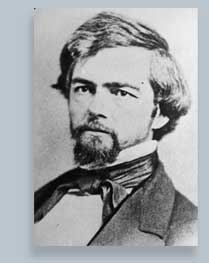Territorial Timeline

Newly elected President Franklin Pierce appointed Isaac I. Stevens as Governor of Washington Territory
On March 17, 1853, President Franklin Pierce appointed Stevens governor of the newly created Washington Territory. In addition to his duties as governor, Stevens was made Superintendent of Indian Affairs with orders to negotiate treaties with all of the Indians west of the Rockies and north of the Columbia River. He also was charged with finding and surveying a northern railway route from the Mississippi to the Pacific Ocean.
Stevens journeyed overland to Washington Territory, following in the footsteps of Lewis and Clark. The railroad survey took time, as did the negotiations with the tribes his party met along the way. Tired and worn, the party finally arrived in Olympia, the territorial capital, on November 28, 1853. The citizens of the capital had prepared a lavish welcome for him, but when the short, exhausted figure in buckskins arrived they took him for just another ragged traveler and shunted him off to the kitchen so that he would not be an embarrassment to the new governor. It took a while for the celebrants to realize their mistake.
Stevens was thirty-five years old at the time of his appointment, the youngest man to serve as governor of Washington Territory and certainly the most active. At once he made arrangements to meet formally with the Indians and to arrange treaties with them. Under orders from the U.S. Secretary of State, Stevens was to settle the Indians on reservations and open the territory to (white) settlement. His treaty-making activities took him as far east as Montana where he met with the Blackfoot Indians. In all, Stevens concluded ten treaties involving scores of tribes.
As illustrated in his speeches and addresses, Stevens had two major goals: to open the territory to settlement and to improve transportation so settlers would come. At the time Washington had only a few primitive wagon roads and trails, and few settlers took the northern fork of the Oregon Trail into Washington. To Stevens, a railroad from the Mississippi to the Pacific was the key to Washington's hope for prosperity and he spent countless hours preparing his railroad survey report. In an effort to make his case before Congress, Stevens ran for the office of Territorial Delegate to Congress in 1857. He was elected and took his multi-volume report to Washington D.C., but the nation was not quite ready to undertake such a task.